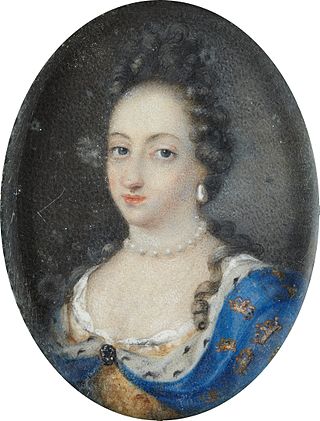
Ulrika Eleonora of Denmark was Queen of Sweden as the wife of King Charles XI. She is often admired for her generosity and charity.

Hedvig Sophia Augusta of Sweden, Duchess of Holstein-Gottorp, was the eldest child of Charles XI of Sweden and Ulrike Eleonore of Denmark. She was heir presumptive to the Swedish throne from her birth until that of her brother one year later and again from the start of his reign as King of Sweden, in 1697, until her death and the regent of the duchy of Holstein-Gottorp for her minor son from 1702 to 1708. Some sources refer to her as Sofia.

Hedwig Eleonora of Holstein-Gottorp was Queen of Sweden from 1654 until 1660 as the wife of King Charles X Gustav. She served as regent during the minority of her son, King Charles XI, from 1660 until 1672, and during the minority of her grandson, King Charles XII, in 1697. She also represented Charles XII during his absence in the Great Northern War from 1700 until the regency of her granddaughter Ulrika Eleonora in 1713. Hedwig Eleonora was described as a dominant personality, and was regarded as the de facto first lady of the royal court for 61 years, from 1654 until her death.

Fredrika Charlotte "Lolotte" Forssberg (1766–1840) was a Swedish noble and lady-in-waiting, later countess Stenbock. She was one of the most talked about people of her time as the possible child of King Adolf Frederick of Sweden. Princess Sophia Albertina of Sweden investigated her birth in the 1790s and tried to have her acknowledged as the daughter of her father. The truth is unconfirmed, though it is considered likely that she was the illegitimate daughter of the king.

Hedvig Kristina Elisabeth "Betty" Deland was a Swedish stage actress. She was a principal of the Royal Dramatic Training Academy and belong to the elite of Swedish 19th-century actors. She was known as Betty Deland until 1857 and then as Betty Almlöf.

Catharina Ebba Horn af Åminne,, was a Swedish noble and the second official royal mistress of King Frederick I of Sweden from 1745 to 1748. She was one of two official royal mistresses in Sweden. She had no influence over state affairs, but she did patronise careers through her powerful connections and her position.
Henrika Juliana von Liewen was a Swedish noble, socialite and lady-in-waiting, politically active on behalf of the Hats (party) during the Age of liberty.

Emerentia von Düben also called Menza, was a Swedish lady-in-waiting, the favourite of Ulrika Eleonora, Queen of Sweden. She was known for her influence over Ulrika Eleonora.
Elisabet Juliana Banér, was a German noble, married to the Swedish Field Marshal Johan Banér in 1636. She is considered to have wielded a certain influence upon Banér and the Swedish army during the Thirty Years' War.
Ebba Mauritzdotter Leijonhufvud, also called Ebba Mauritzdotter Lewenhaupt, Countess of Raseborg, Lady of Käggleholm, Eksjöhovgård and Tullgarn, was a Swedish noble and courtier and member of the Leijonhufvud family. She served as överhovmästarinna in 1633–1634 and foster mother in 1639–1644 to Christina, Queen of Sweden. She was also known for her donations to various churches.
Juliana Sophia Schierberg, known as Julianchen was a Swedish favorite. She was the personal chamber maid and influential confidante of Princess Hedvig Sophia of Sweden and known for her influence and political activity.
Anna Maria Clodt, was a Swedish courtier. She served as a Danish agent at the Swedish Royal Court and was widely reputed and consulted by supplicants for her contacts and acquired a great deal of influence.
Ulrica "Ulla" Elisabeth von Liewen, was a Swedish courtier and baroness. She was at one point the royal mistress of Adolf Frederick, King of Sweden and is known as the likely mother of Lolotte Forssberg.
Hedvig Elisabet Strömfelt, née Wrangel, was a Swedish courtier. She served as överhovmästarinna to two queens of Sweden, Ulrika Eleonora of Sweden and Louisa Ulrika of Prussia, and as Royal Governess to the royal children. Gustav III of Sweden refers to her with affection and admiration in his writings.
Sophia Amalia Marschalk, also called Anna Marschalk, was a Danish noble and courtier. She was the favorite of the queen of Sweden, Ulrika Eleonora of Denmark.

Elsa Elisabeth Brahe, was a Swedish countess and duchess, married to Adolph John I, Count Palatine of Kleeburg, Duke of Stegeborg, the brother of king Charles X of Sweden.
Beata Magdalena Wittenberg (1644-1705), was a Swedish courtier.

Events from the year 1693 in Sweden

The 1719 Instrument of Government adopted on 21 February 1719 by the Riksdag of the Estates, was the constitution of the Kingdom of Sweden from 1719 to 1720. Although only in force for a few months, it has great significance in Swedish history, as its promulgation marked the end of the country's first period of absolutism (1680-1719) and the beginning of the period of constitutional monarchy and parliamentary government traditionally known as the Age of Liberty.

Tapetskolan vid Karlberg or Tapetväfveriet vid Karlbergs slott, also called Karlbergsfabriken, was a Swedish orphanage and a school for girls. It was founded by Ulrika Eleonora of Denmark, Queen Consort of King Charles XI of Sweden. She founded a large number of charitable institutions which were paid by her personally. The handicrafts school was situated at the royal summer residence Karlberg Palace which King Charles XI had purchased in 1688.











